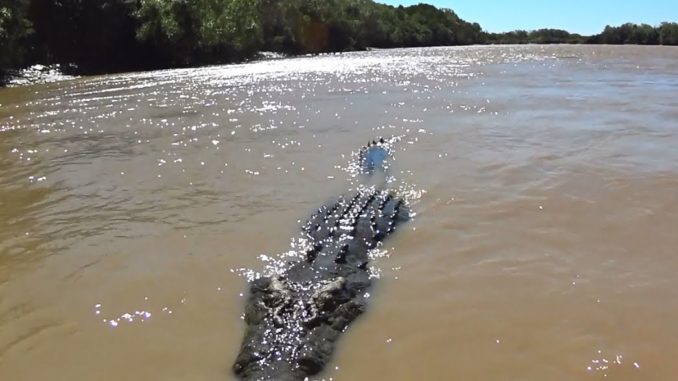
There are Aussie pelicans in the Kaipara, but is the Maori ‘taniwha’ or Ngarara based on encounters with another Aussie migrant?
An old scientific study from the 1980s indicates Australian saltwater crocodiles are occasional summer visitors to New Zealand and probably the cause of ‘taniwha’ stories.
This extract from a report written by archaeologist Simon Best in 1988 lays out the case:
Even so, the suggestion that New Zealand might have been a landfall at the end of such a journey would be of no more than academic interest had it not been for an incident off the North Cape of New Zealand in 1970. In the last few days of February of that year the second officer of – 252 the M.V. Parera, a coastal trader of the Holm Shipping Company en route from Auckland to Brisbane, was the first to spot an object in the sea over two miles ahead and to starboard of the ship. The sea was “like glass” (Capt Brown: personal communication) and the ship’s course was altered to investigate the sighting. The captain, second mate and bosun had a clear view of the animal as the vessel passed, and, after the Parera reached Brisbane, Captain Brown wrote to the Marine Superintendent of the Holm Shipping Co. in Auckland reporting the sighting. Part of the letter is reproduced below:
About 300 miles from the North Cape and 800 miles from Brisbane, off the Wanganella Bank we passed a crocodile about 15 feet long in broad daylight. The Second Mate saw it first ahead of the ship and we passed it about 20 feet off alongside the bridge. It was swimming quite strongly. We did not see its head clearly as that part of it was in the wash from the bow, but the body appeared to be that of a crocodile so presumably it had a crocodile’s head. If not then your guess is as good as mine as to what it was. As the wash touched it it sounded, showing a whitish-grey belly. It had a row of triangular spikes three or four inches high running down its back on each side of the spine. I had the binoculars on it so at that range I got a good look and there is absolutely no chance that it was a turtle, whale, porpoise, shark, tree, or anything else but what I have described. . . . (letter from Capt C. A. Brown to Capt R. Jackson, 4/3/70).
A copy of this letter was sent to Dr Turbott, then Director of the Auckland War Memorial Museum, and also to Professor J. Robb at the University of Auckland. Both identified the sighting as that of a specimen of C. porosus, Robb in both a newspaper article (N.Z. Herald 1970) and later in her publication on reptiles and amphibians in New Zealand (Robb 1980:98), although in the latter the month of the sighting is incorrectly given as April.
This animal is most likely to have come from the Australian coastline, the nearest point of which is some 1300 km from the sighting. The southern limit of C. porosus on the eastern coast is about 100 km north of Brisbane (Cogger 1979:118), although it is possible that the animal came from considerably further north, as the crocodile population in the lower part of the east coast is not as dense as that around the top part of the country. An open ocean journey of at least 1300 or 1400 km was thus achieved, and that the animal was still swimming strongly indicates that it was by no means at the end of its tether, and, barring accidents, could have made a landfall in New Zealand a short time later.
– 253
The question arises that, assuming such an event took place, how would the animal fare in the colder climate of its new surroundings. Firstly, the larger the crocodile the less it would be affected by the cooler climate. Cott states, “size is an important factor in an animal’s thermal relations with its environment. The larger the animal, the lower is its surface-to-bulk ratio and the greater its capacity for heat storage” (Cott 1961:227). He also points out (p.226) that as a heat source, solar radiation is far more important than air temperature. Thus, a crocodile will climb out of water and sun itself before the air temperature has reached that of the water just left, it being “. . . so delighted with the sun-shine, & lieth therein so immoveable, that a man would take it to be stark dead” (Topsell 1979:119). Another factor that could influence the likelihood of a successful landing is the general weather pattern. In the last 1000 years maximum temperatures have fluctuated up to 1.5 °C. between crest and trough, with the highest peak in the 14th century, some 0.7 °C. above the next highest, in 1950. Recent temperatures, however, have been even higher (Burrows and Greenland 1979:331,332).
There is little doubt that a large crocodile, arriving today on the New Zealand coast in the summer months, would be able to survive and function normally, at least until the onset of winter. If it landed in the upper part of the North Island, probably the most likely area, then it is also possible that it could survive mild winters. Such a situation would probably mean that the animal spent more time out of water than normal (see above).
From the sightings described above, it thus appears not only that is it possible for a large specimen of C. porosus to cross the stretch of ocean between Australia and New Zealand, but also that this event may well have occurred at some time in the past. The arrival of such a totally unknown and terrifying creature, five to six metres long and weighing up to a tonne, catching its victims with bone-crushing force and taking them out of sight into another world, is surely the stuff of which legends are made.
New Zealand, however, is not the only Polynesian island group with stories concerning giant man-eating lizards.
It’s not the first time crocs appear to have made the crossing. In early February 1869 newspapers reported an “alligator” in a coastal lake north of Wellington.
A more detailed account followed:
In 1886 there were reports of a child’s arm being bitten off, and a crocodile sighting in the Waikato river:
 Which means this report from Taranaki could have been the body of one of these:
Which means this report from Taranaki could have been the body of one of these:
Giant dinosaur, long as a bus, head like ‘dragon’, at large in New Zealand
In 1989, reports Scientific American, a study confirmed another crocodile had been seen literally at the tip of New Zealand’s North Cape:
“Saltwater crocs often frequent estuaries, lagoons and mangroves, but animals in some populations spend some or all of their time at sea. Extralimital records from the Cocos Islands southwest of Sumatra, from Fiji, and even from 48 km north of North Cape in New Zealand (Steel 1989 [Steel, R. 1989. Crocodiles. Christopher Helm, London.]) demonstrate an ability to travel far out to sea.”










